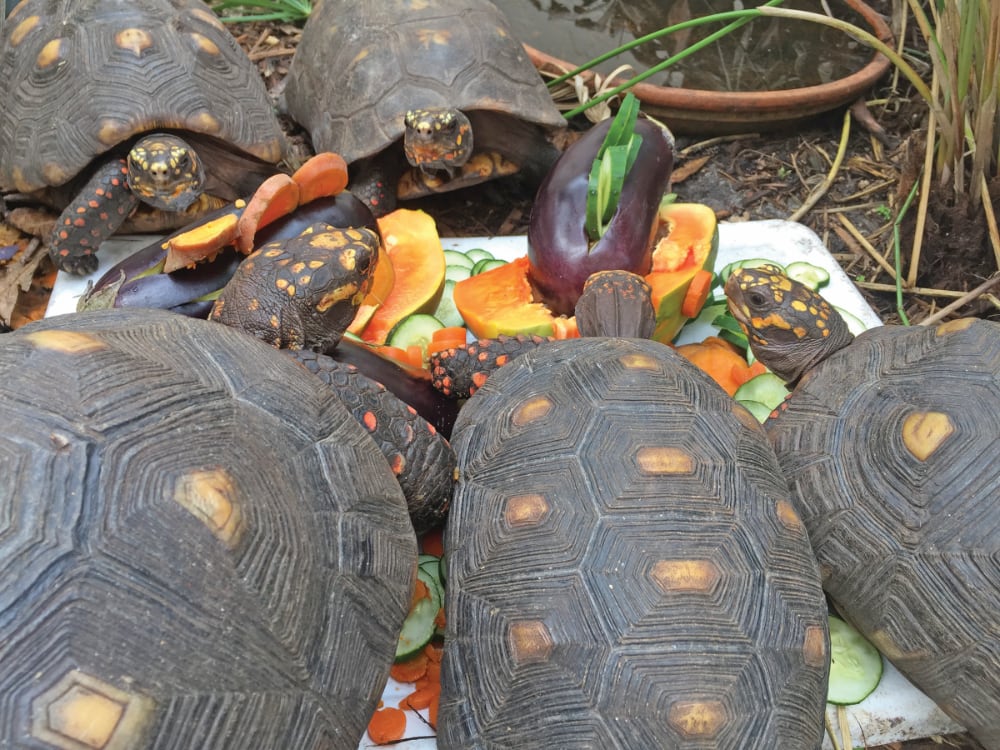Keeping red-footed tortoises is a privilege and an enjoyable experience for keepers who are prepared for their requirements.
The red-footed tortoise (Chelonoidis carbonaria) is a favored and commonly kept captive species in the United States. Their beautiful natural colors, manageable care requirements, and fascinating behaviors make them very rewarding to keep. REPTILES magazine has published multiple articles on the species and the information database just continues to grow. The red-footed tortoise seems to truly thrive in captivity under the proper conditions.
Many states are described as having subtropical climates, which would be the preferred captive habitat choice compared to the drier climates. Regardless, it is possible to give them a high quality life in dry areas with the proper modifications. For keepers in the United States, there are a range of captive breeders and hobbyists found in South Florida. This is due to the tropical climate which is similar to the natural ranges of the red-footed tortoise.
To successfully keep any tortoise species, it is important to understand that replicating their natural habitat should be the goal, along with providing them a high quality of life. All tortoises truly appreciate the natural sun, which is a way they gain important nutrients for their health. For example, it makes them digest better, grow stronger shells, and stay balanced physiologically. Humidity is also a crucial aspect of their care. Like all tortoise species, they need daily attention from their owners.
Red-footed tortoises have been popular with reptile keepers for many years, and captive-breeding has removed most pressures of wild collection of the species. According to some, it has also made it harder to follow bloodline tracing between localities. Red-footed tortoises are small- to medium- sized tortoises (reaching a maximum length of about 15 inches) and have distinct red feet.
There are no subspecies currently recognized but instead localities which are isolated within many regions, such as Brazil. These localities range in multiple regions of South America with characteristics like color and size being specific to an area. Some have debated captive-breeding as controversial because of the mixing. These localities include color variants like the bright “cherry head” red-footed tortoises, the “yellow” Colombian red-footed tortoises, and large sized Bolivian red-footed tortoise to name just a few. Crossed specimens are common in captivity while color morphs like albinism are more rare.
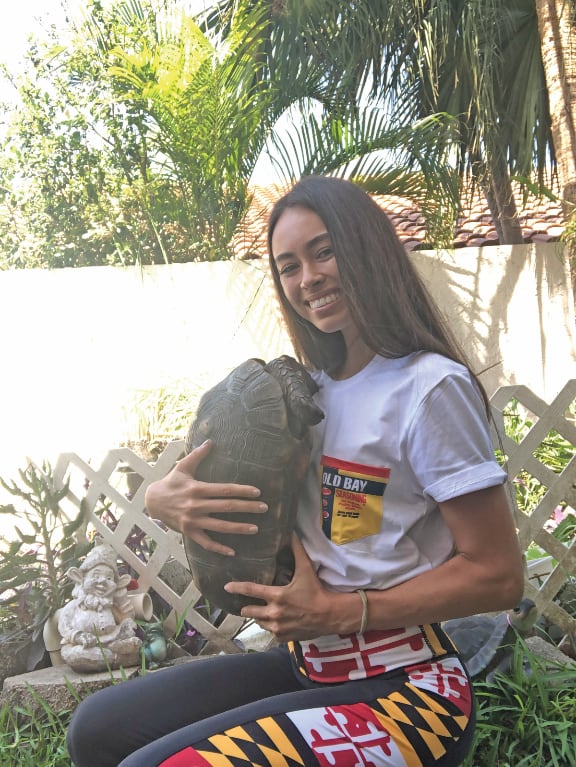
The author with a red-footed tortoise.
Red-footed tortoises have proven to be a hardy species for those prepared for their lifestyle requirements. Multiple academic and hobbyist papers are published on red-footed tortoises. When it comes to exotic animal care, research is an important and ongoing step. As we continue to learn and care for red-footed tortoises, each experience will be different for the individual animal and keeper.
Red-footed Tortoise Habitat
Red-footed tortoises are a new world species that are native to the tropical rainforests and savanna habitats of South America. They require humidity for proper health which is very easily attained in places such as South Florida. The mimicry of a ‘wet’ and ‘dry’ season is extremely advantageous to keepers here. In drier areas, humidity can be supplemented by spraying the habitat down frequently when temperatures are warm. As adults, red-footed tortoises are generally a smaller size compared to some other species, which makes them more manageable. They still eventually require a spacious habitat. Outdoors in Florida, no artificial lighting is required when they are living outside.
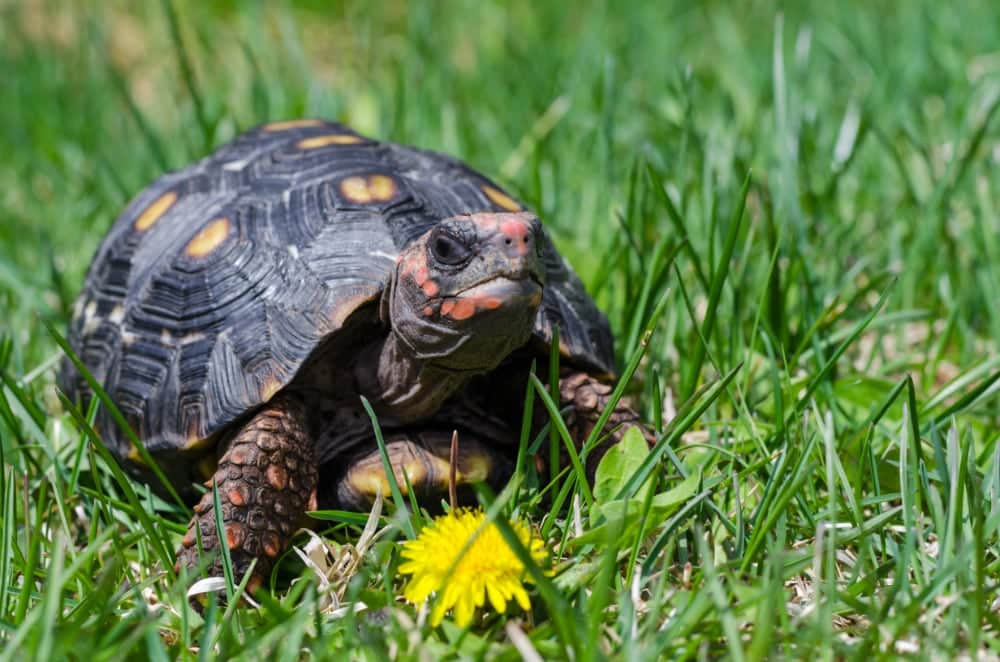
Red-footed tortoise enjoying the outdoors. Photo by Chase Clausen/Shutterstock
They are typically kept at a steady temperature between 75-90 degrees Fahrenheit (23.9 to 32.2 degrees Celsius) with 50 to 100 percent humidity. Artificial lighting and supplemental humidity are required for areas that do not replicate the native climate of the red-footed tortoise. Hygrometers and thermostats are especially helpful for those replicating these conditions indoors. These tools help you monitor the conditions. In South Florida, the occasional winter night calls for ceramic heat emitters either indoors or outdoors to keep them warm.
Our adult red-footed tortoises are kept outdoors in a habitat with a fenced perimeter, which can be made of various materials. From my experience, they are considerate of the barriers and do not try to break through them as long as they cannot see through them. We use standard brick and bamboo fencing which they cannot see through. A considerable amount of space is what any adult tortoise deserves, and so a large property with plenty of open space would be a great option for them.
Substrate differs depending on the region, but we keep our outdoor tortoises on a mixture of sugar sand and cypress mulch. Because of Florida’s wetland tendencies, drainage is extremely important to consider for the habitat. Too much moisture causes them to easily get fungus on their shells, which is something many keepers struggle with in South Florida. Drainage can be attained by having a slanted area for run off, and large rocks (such as river rock) in certain areas of the habitat where tortoises can remain dry.
For hatchling tortoises up to a few years old, we keep them in a more artificial habitat using large, plastic bins. We separate them depending on size and age. We do not mix large and small red-footed tortoises. Young red foots can be kept happily in simple containers with the proper temperature, lighting and humidity. We have used standard containers from Home Depot, the bottom portions of rabbit cages, horse troughs, and other simple industrial bins. These bins should be at least eight inches tall and three feet long. Avoid clear or black bins.
When tortoises can see out of the habitat, it can stress them out and cause constant scratching at the walls. Black bins can absorb too much heat, so use lighter, solid colored bins. If kept in a colder area with less natural humidity, modification of plastic bins may be required. We generally avoid glass terrariums (especially outdoors) because of magnified sunlight which can trap heat and cause an abundance of microorganisms.
Red-footed Tortoise Substrate
For substrate within these habitats, we keep hatchlings on Exo Terra forest moss that is semi-moist. It is important they do not eat the moss, so feeding should be in a dish within the container. We keep them here when they begin hatching from their eggs and while they absorb their yolk. Once they are a bit older, we use cypress mulch, Zoo Med’s Repti Bark, and Coco chips as suitable substrate options. Spraying the substrate is a great way to increase humidity, but too much wetness can cause health problems both indoors and outdoors.
For indoor lighting and heating, we typically use the Exo Terra Solar Glo All In One Reptile Bulb as artificial lighting for our baby red-footed tortoises. This bulb provides UVA, UVB, and UVC in one bulb, which is required for a healthy, growing tortoise. A large fixture with a stand or clip is required for this very large bulb. The bulb is kept on one side of the habitat to create a “hot” and “cool” side. It is important to note that these bulbs lose their vital spectrums every three to six months or so and must be replaced even if the light is still shining. This has been a convenient and successful option for us that is available readily from pet stores and online. Young tortoises that we keep outdoors do not require this artificial lighting.
Red-footed Tortoise Hides and Shade
Indoors or outdoors, adults or hatchlings, proper hides and shade spots are an essential part of our tortoises’ habitats. This provides them with areas to regulate their temperatures, hide, sleep, and more. It is important to consider the shape of the hides so as to avoid tortoises climbing and flipping over. Flipping over on their backs could be a deadly event if they are under a light or in the direct sun for too long, so we avoid anything with a rounder shape they could easily climb and flip themselves with. This is one of the reasons why you must give tortoises daily attention.
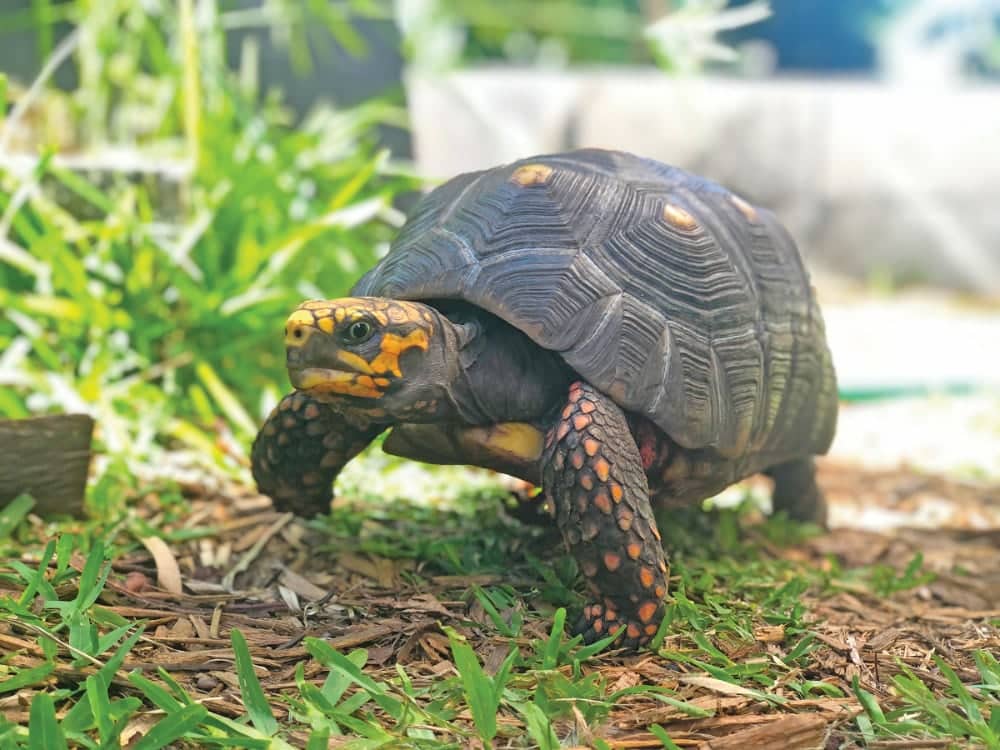
Red-footed tortoise seeking shade. Photo by Rebekah Pettit
Red-footed Tortoise Diet
Red-footed tortoises are described as omnivorous, enjoying items from leafy greens, to fruit, to protein. Variety is the most important part to any tortoise diet, and all diets are species specific. For the redfoots, they will eat just about anything, but spinach, citrus, and too much protein should be avoided.
We focus on feeding our red-footed tortoises a varied diet that includes leafy greens like spring mix, romaine, green and red leaf lettuces, turnip greens, collard greens, dandelion greens, etc. Fruits such as papaya, strawberry, blueberry, blackberry, loquat, grapes, and apple are also fed, as are Mazuri pellets, hibiscus flowers, muscadine leaves, squash, and occasional root vegetables like sweet potato, to name a few.
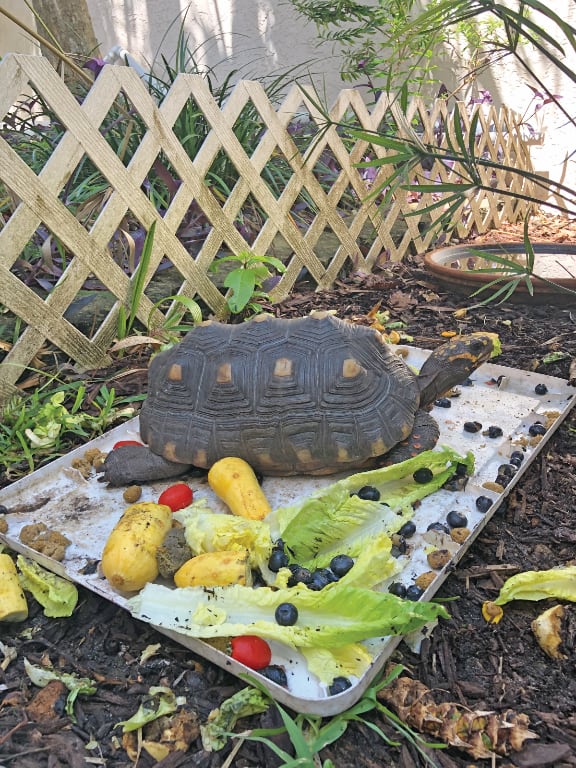
Red-footed tortoises enjoy a varied diet. Photo by Rebekah Pettit.
For occasional protein, we typically feed commercial Mazuri pellets or boiled chicken. In the wild, red-footed tortoises will scavenge on carrion but too much protein can cause pyramiding in tortoises. Greens high in oxalic acid should be avoided along with most citrus besides seasonal loquats. We feed our tortoises at least once a day, unless it is a rather cold day (which helps avoid digestion issues). Turtles and tortoises have a strong sense of smell and they are very sensitive to bright colors found in fruits and veggies. Be aware that outdoor feeding can attract predators or other wildlife depending on location. This is another reason daily attention is required for all tortoises.
Water
For adult tortoises, water dishes are provided as simple, shallow, plastic or stone planters. Water should be changed daily and should always be available. For hatchling tortoises, we avoid the possibility of drowning by instead soaking tortoises daily in room temperature water. Tip of advice always set an alarm to remember they are soaking! It is very helpful because it is easy to walk away and be forgetful if you do not. Soaking tortoises helps them stay hydrated which is especially important in very hot areas such as South Florida. Without proper hydration it is very common for reptiles to die while living outdoors here.
Daily Care of the Red-footed Tortoise
Daily care is required for all tortoise species. It is also important to consider that tortoises live for many decades and might possibly even outlive you. Tortoises are not an animal you can just leave and go on vacation carefree. They need to be checked on daily and provided the proper husbandry.
Captive Breeding of the Red-footed Tortoise
Captive breeding of the red-footed tortoise has been successful for keepers all over the country. Wild-caught red-footed tortoises are often imported with parasites, so captive bred specimens are preferred over wild caught ones. For breeding, red-footed tortoises seem to do better in groups with male competition, so at least two males are recommended in a breeding group. In my experience, as long as they are similar sizes, males and females are kept together peacefully without issues.
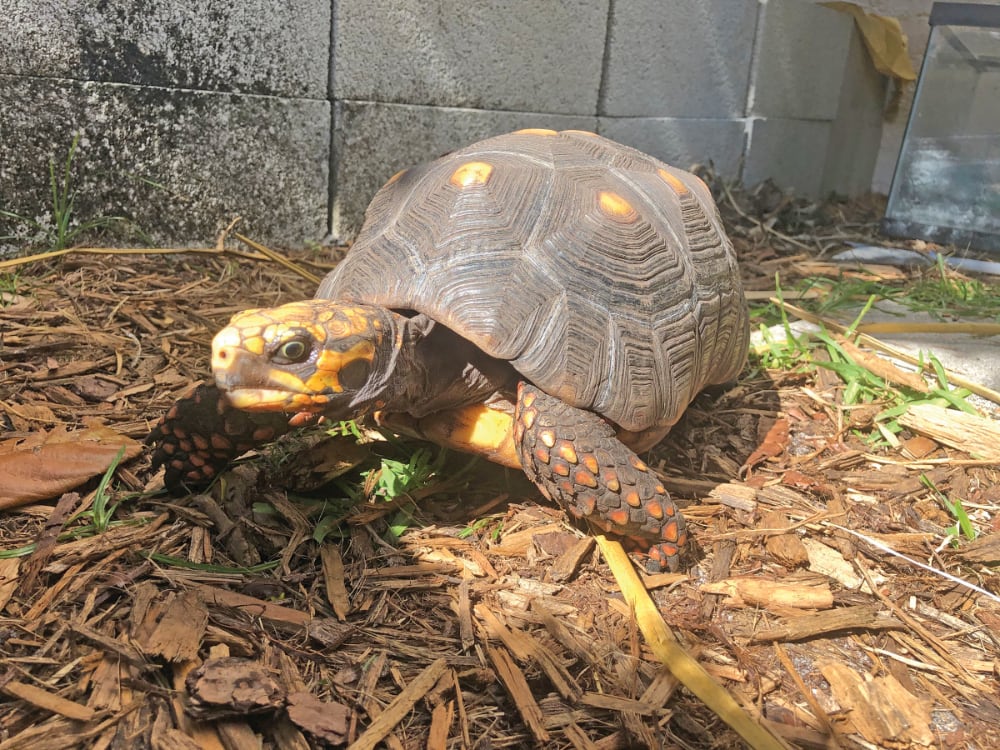
Red-footed tortoises need a large enclosure. Photo by Rebekah Pettit
We do not cohabitate different tortoise species. Cohabitation is not recommended for many reasons, including (but not limited to,) behavior differences, husbandry requirements, and pathogenic microorganisms.
Red-footed tortoises reach sexual maturity and breeding size usually between 4 to 6 years old. In South Florida, breeding is constant and eggs are laid throughout the year. Males have distinguished, individual vocalizations when mating and you will come to recognize and identify specific males by their mating sounds. The concave plastron helps males properly mount and mate with females. Females will nest and lay their eggs in a specific area after they stomp around and sniff for the perfect place. Once she finds the perfect spot, a delicate chamber is created with her back legs and she carefully deposits her eggs in the space.
We try to hand catch all eggs although there have been a couple times we did not see a nest and they were laid and incubated naturally. It is always a fun surprise when baby redfoots are spotted in the yard! This is when a proper perimeter is especially helpful.
How Often Should I Let My Red-Footed Tortoise Soak?
For the usual process though, we incubate each clutch in a home incubator. After a clutch is laid, we carefully document the orientation, date, and female’s initials with a pencil. Then, we place them into an airtight plastic container with vermiculite or perlite substrate with a mixed 1:1 weight-to-water ratio. It is important not to move or rotate the eggs once they are placed in the incubator. This could detach the developing embryo and cause death.
Many methods have proven to be successful for artificial incubation of red-footed tortoises and research is encouraged. With proper husbandry and care, viability percentages seem to be higher than other tortoise species, especially when breeding seasoned adults. As they continue to breed and become older, they seem to have better egg viability. Clutches can range anywhere between one to 10 eggs and females can lay multiple clutches per year. The success of artificial incubation depends on many factors. In some cases, it is trial and error to your specific process. Typical incubation for us is between 76-88 degrees Fahrenheit (24.4 to 31.1 degrees Celsius) with 100 percent humidity.
Like many reptile species, the sex is determined by the incubation temperature. Lower temperatures are typically male and higher temperatures are typically female. Mid-ranged temperatures can often produce a 50/50 ratio of males and females. With proper temperature, humidity, and monitoring, incubation has been successful for many captive breeders.
Hatchlings
After about four months, red-footed tortoises hatch out of their eggs. Hatchling tortoises “pip” from their eggs with an egg tooth they have at birth, which eventually falls off. This creates a small hole in the shell of the egg to help the tortoises evacuate. Sometimes, we will help them by carefully expanding the opening a bit more. Once they begin hatching, they are left in the incubator for a day or two and are then moved into a container of moist moss.
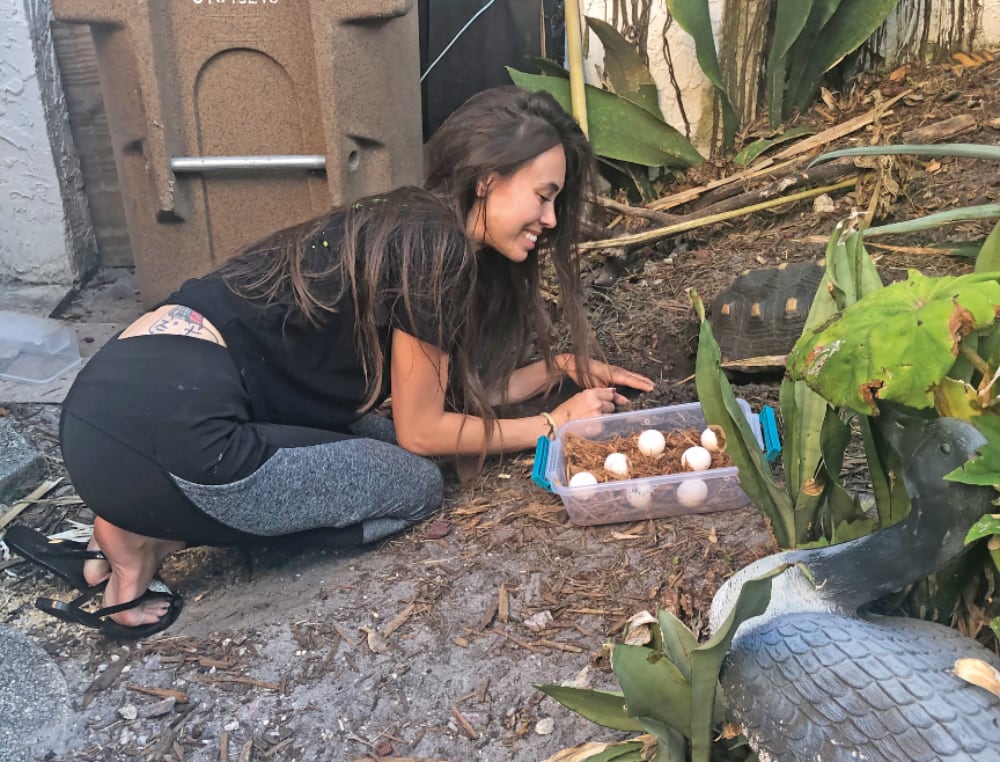
The author collecting eggs for incubation. Photo courtesy Rebekah Pettit.
They can remain in their egg (shell) during this time as long as there is proper air flow. Here they will remain for a couple days while they are absorbing their yolk and starting to leave the egg. The yolk is the structure that keeps the baby tortoises attached to their egg when they are developing. This is why orientation is important during incubation. If the eggs are moved around too much during development, there is a risk of it detaching and the tortoise dying.
When they finally hatch out completely, the yolk remains on the plastron of the tortoise. It is a fragile structure that we are especially careful with when moving them around during this stage of their life.
Substrate that is too dry can damage the yolk causing serious injury or death. This is why moist moss is required during this stage. The first week they are typically not very active while this is absorbing into their body. Over a short period of time, it completely absorbs and is no longer visible.
This yolk is basically a blob of nutrients that helps them gain energy when they first hatch so they do not have to search for food. Once it is absorbed, they begin to eat “real” food, although we have had hatchlings that began eating even when they were still absorbing, so we always offer food right away. This is typically leafy greens like spring mix (without spinach).
Once we start offering food, we put them into the previously mentioned hatchling habitat. In the beginning months of their lives, hatchling red-footed tortoises have softer shells. Tortoise shells are made of the similar protein that makes up our fingernails. This is strengthened by consistent husbandry, hydration, and diet (between 2-5 months). After their shells become strong and they eat very well, this is when we determine they are “well started” and ready to go to their new homes.
Misplaced or split scutes are a common defect from artificial incubation which creates extra or distorted scutes on the shells of tortoises. It is not usually connected to any major health issues. Pyramiding is another common shell defect usually caused by an improper diet. Hydration is extremely important for hatchling tortoises and our hatchling red foots are soaked daily, even while their yolks are still absorbing.
Keeping red-footed tortoises is a privilege and an enjoyable experience for keepers who are prepared for their requirements. It really is a pleasure to care for and breed such special animals. Like all reptiles, their husbandry and care is species-specific and it is especially important to consider that tortoises live for a very long time.
Having an exotic vet for your reptiles is important for proper medical advice and health questions. Red-footed tortoises make wonderful companions personally and for breeding projects, especially for those who live in similar climates to their natural ranges. It is such a wonderful experience to care for red-footed tortoises who are very personable and conditioned to captivity. They seem to love human interactions like feeding and shell scratches! Captive-bred red-footed tortoises truly thrive with proper care and with those who love them.
Rebekah Pettit is a zoologist and middle school science teacher based in Florida. She and her husband operate Trademark Exotics (Instagram.com/Trademark.Exotics).

